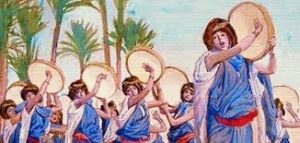Raboyseyee and Ladies,
Female Sexy Voices:
Shoin: just last week (until the end of the parsha), the Yiddin were -says the Meshech Chochmah- still enslaved and had slid down to the 49th level of tuma (impurity) having committed all kinds of sins. What kind? Ver veyst? 49 levels down, we imagine they touched all the bases, if you chap. Says the medrish: millions perished for their less than exemplary behavior. What a difference one shabbis makes. This week they are free, mamish. After a brief period of heightened exuberance capped off by singing and praising the RBSO for His efforts, they will quickly revert back to their old ways and habits. We will be reading more about their shenanigans next week, and in all of Sefer Bamidbar; stay tuned.
A lot going on in our parsha, ober this year -year 14 of parsha posts- we will only cover one, maybe two topics. Les-man-dipolig (few would argue) that kriyas yam suf- the splitting of the sea- was one of the biggest nissim (miracles) the RBSO performed on behalf of His -about to become- Chosen People and you can read all the details in this week’s parsha. We have previously covered most of the parsha in years 2011-2023. Feel free to read the heylige Ois’s insights at www.Oisvorfer.com. You should! This year we’ll begin our parsha review with the song that the Yiddin spontaneously sang following their safe arrival onto dry land. And avada you all know that as a result of Moishe’s famous Oz Yoshir single, this shabbis is also called Shabbis Shira (shabbis of song). Spirits are uplifted and many are taka inspired as the baal koirah (Torah reader) chants its 19 verses with special cantillations. Ober what happened immediately after Moishe led the Yiddin in song?
Says the heylige Toirah (Shmois 20, 21) azoy: “Miriam the prophetess, Aharoin’s sister, took a drum in her hand and all the women followed with drums and with dancing. And Miriam led them in song, ‘Sing to G-d for His great victory, horse and rider He cast into the sea’”.

Did we just read the Miriam and other women sang, played instruments, and also danced in front of the men and no one complained? When the Ois was growing up, all three of these activities were strictly forbidden. And even if they weren’t, they are today. Women singing in earshot of men and efsher also dancing? Yikes! Unheard of, unthinkable and unacceptable, ober what taka took place? Hey, what happened to kol Isha or Koil B’isha Erva (a woman’s voice is a sexual stimulant), a law put on the books by some rabbis proclaiming that women’s voices were mamish sexually stimulating? And mixed dancing? Oy vey! What’s pshat here and how is it that the heylige Toirah seemingly didn’t have an issue with Miriam and her first ever all-women’s band and choir singing, performing and dancing in front of all the men? Is this muttir (permitted)? And if it was back then, what happened since? Or, can we kler that efsher since they all just finished a general mixed swim in the ocean, that mixed singing and dancing was or is also mutir? Nu, lommer lernin.

Says the heylige Gemora (Brochis 24a) azoy: “a woman’s voice is a sexual stimulus” and accordingly, the good rabbis, worried that chazerim -like many of you- would listen to women sing and then -chas v’sholom (heaven forbid)- become stimulated, if you chap, and then act out in chazerish fashion. Accordingly, they forbade koil Isha (woman’s voice). Shoin, fartig (over and done), women’s voices were silenced. In fact some hold that men shouldn’t even talk to women for that reason. Some are more machmir (stricter) and don’t talk to their own wives. Typically, those in the latter category have other reasons; seemingly they’re stam (generally) tired of hearing her voice altogether.

Over the years many have pontificated over this issue and of course dissected every word of the few sentences describing this event to see if Miriam and the girls (women) really sang, sang only with other women, with the men, before them, or after them, ver veyst. Were they standing in the back, in the front, or efsher up in the balcony? Was there a mechitza? One thing is zicher: there is no consensus and seemingly no eye witness to tell us what happened. Even Serach bas Asher is gone. Then again, the heylige Toirah does tell us that she sang. Case closed? Not! Efsher she and her band were only lip synching, a model since copied by other famous performers from time to time, and Miriam’s singers, were efsher the first lip synching band in recorded history, ver veyst. A few even suggest that the entire episode didn’t take place: she wasn’t singing at all. But doesn’t the heylige Toirah tell us that she sang and banged away at the instruments the women brought along for mamish such an occasion? Indeed it does but that didn’t stop those who could not fathom that the heylige Toirah allowed this to happen, to drum up their own version of what took place at the bandstand. Of-course it’s difficult for the good rabbis to prohibit something that is clearly permitted in the heylige Toirah; taka says the TAZ that the Sages are unable to forbid something the heylige Toirah explicitly permits- the heylige Gemora cannot contradict the Toirah. Instead, they went about trying to figure out if the entire story actually took place. And if it didn’t, they could prohibit it. In other words: if the heylige Toirah says it’s mamish ok, the Gemora cannot prohibit it and the question is, did it or didn’t it happen? Not so gishmak but deviously insightful. Shoin, let’s then begin by reading innaveynig (the text of the heylige Toirah), let’s mamish study the words.
| כ וַתִּקַּח מִרְיָם הַנְּבִיאָה אֲחוֹת אַהֲרֹן, אֶת-הַתֹּף–בְּיָדָהּ; וַתֵּצֶאןָ כָל-הַנָּשִׁים אַחֲרֶיהָ, בְּתֻפִּים וּבִמְחֹלֹת. | 20. And Miriam the prophetess, the sister of Aaron, took a timbrel in her hand; and all the women went out after her with timbrels and with dances. |
| כא וַתַּעַן לָהֶם, מִרְיָם: שִׁירוּ לַיהוָה כִּי-גָאֹה גָּאָה, סוּס וְרֹכְבוֹ רָמָה בַיָּם. {ס} | 21. And Miriam sang unto them (alternatively: Miriam answered them): Sing ye to the LORD, for He is highly exalted: the horse and his rider hath He thrown into the sea. |
Nu, as we just read in posik 21, it appears that Miriam mamish sang ober others suggest that based on the wording, specifically the Hebrew word of Va-ta-an- (see verse 21 above) that Miriam did not at all sing. If not singing, what was she doing and why did we all grow up thinking that she did? Nu, let’s see what a few had to say about what took place.
Citing the Mechilta (a medrish), says Rashi azoy: she did sing ober Moishe sang the song to the men and they responded after him. Separately Miriam sang the song to the women and they responded after her. Ok- they both sang ober maybe not together and all is kosher. Say others: Miriam sang for the women and (perhaps while) Moishe sang for the men. And says Reb Aryeh Kaplan (The Living Torah) azoy: the women sang at the same time as the men. OMG! And says the Yalkut Shimoni: va-ta’an refers to actual singing, implying that Miriam sang the song. Ok she sang and so what? Says Rashi -and of course he knew- not to worry because the women seemingly had a separate sing-off. Moreover, he suggests that neither Moishe nor Miriam really sang their songs; they merely chanted them as poetry of praise. Chanting and singing are not the same. Got all that?
Says the Medrish azoy: seemingly the malochim (angels) wanted to sing praises to the RBSO before the women but Miriam answered them and called for the women to sing. This explains the language of va-ta’an as meaning that she answered the angels, and gives significance to her calling the women to sing. She did sing!

Said Reb Saadia Gaon: she did sing but not exactly. Miriam and the women recited -meaning spoke – in alternation, Moishe’s entire song, ober says Targum Unkelos not so: the women sang the song.
Ober said the Radak (Sefer Ha-Shorashim) azoy: the word va-ta’an does not mean that she answered; instead it means that she testified. She did? According to the Radak, she merely was answering or testifying that was Moishe sang was correct. So says also Reb. Zalman Sorotzkin (Oznaim La-Toirah) where he similarly explains that Miriam only indicated her and the women’s approval to Moishe and the men’s song. She/they answered the men, in agreement to the men’s song.
What happened back then in the midbar, ver veyst? Seemingly she (Miriam), according to many, did sing, dance and play an instrument. How do we know this? Because the heylige Toirah says so and who are we to argue with the RBSO? No good can come from that. Ober as the people (the Yiddin) became bigger and bigger oisvorfs the rabbis had enough and efsher because going back a few decades), many orthodox shuls hosted social mixers during which men and women mamish danced together, cholila- say it’s not so please, the rabbis decided that it was time to take another look at the gantze Miriam singing incident in this week’s parsha and many decided that it never happened. She was there but didn’t sing. Maybe she had a sore throat and couldn’t sing that day, ver veyst? Efsher (maybe) she sang but was off key, or, maybe she was merely davening loud. Other creative answers as to what happened -or not- are all offered. One thing is zicher: mixed swimming did the Yiddin go as they crossed the Red Sea and few complained. Maybe the women were wearing early versions of the shvimkleyd (modest women’s bathing suit/ensemble), ver veyst. Or did they? Mistama in years to come, we will read that the men and women crossed separately as well, ver veyst? Zicher there’s still room for more revisionism.

And says the Me-Am Loi’ez, (Reb Ya’akov Culi) mamish gevaldig azoy: Miriam and the women used musical instruments while Moishe and the men did not. Taka why? Seemingly the instruments were intended to drown out the sounds of the song so the men would not hear their sexy voices and become overly stimulated. Overstimulated men in a hot midbar (desert) can lead to trouble, as we will learn soon about their behavior with the Midianite and Moabite meydlich, if you chap- which seemingly they did. In other words, they did sing but since they were also playing instrument, their voices were masked and therefore this is not considered koil Isha and therefore the men weren’t stimulated, did not have to resort to playing with their own instruments, if you chap, and the rabbis were happy. Shoin!
Ober listen to this even more amazing version. Says The Chida (Devash Le-Fi, ma’arekhes kuf, no. 19), this bombshell: it’s taka emes that the men and women sang together and the men mamish heard their voices, ober it was kosher. Why? Because the RBSO was seemingly there, His Divine Presence rested on them. Therefore, mixed singing was not a problem; with the RBSO or His presence in attendance, women singing or mixed singing so that men could hear their voices, was not prohibited. So mamish gishmak. Nu, be sure to invite the RBSO to the next party. Find Him in the cloud. And of course, that’s why wherever a person goes, he should go with the RBSO. Pow, bam, and gishmak!
Ober said the Vilna Gaon (quoted by the Talelei Oirois) that it’s not emes and there is a reason that the heylige Toirah used the word Va-ta-an when Miriam took over the festivities. It means that Miriam and the women would not sing because the men would not be allowed to hear them. In other words, the women did not sing. And taka, believe it or not, the heylige Ois went searching into different interpretations of the word va-ta-an (verse 21) and found at least 7 different ways that the word is used, depending of course, on someone’s personal bias.
- “And Miriam answered them”
- “Miriam sang to them”
- “And Miriam sang to them”
- “And Miriam sang unto them”
- “And Miriam chanted for them”
- The Living Torah – “Miriam led them in the response”
- Artscroll / Stone Tanach – “Miriam spoke to them”
Which is it? Ver veyst?
Ober says the Malbim azoy: the women sang their own song because the entire Exodus was due to the merit of the righteous women. Da’as Mikra also interprets the verse as meaning that Miriam and the women sang their own song together. And says the Netziv: not only did the women sing, they composed their own song and Miriam concluded each stanza with the refrain recorded in the Toirah. She was also a composer. Gishmak!
And said Rabbi Samshon Rephael Hirsch: they sang in tandem with the men initiating the song and women responding by repeating it. Oy vey and they still got the Toirah a few weeks later? Seemingly yes! And listen to this: says Hirsch: the women’s singing was of equal importance to the men’s. Taka why?
Says the Malbim (Rabbi Meir Leibush Weiser): the women claimed that all of this (the redemption from Egypt) occurred in their merit. How so? Nu, zicher you remember that it was Miriam and Princess Batya that saved Moishe when he was cast into the Nile and that Shifra and Puah (Yoicheved and Miriam, according to Rashi) who defied Paroy’s orders. Therefore, they insisted on singing separately, since they had (such) a (large) share in the miracles.
The bottom line: Whatever happened there, seemingly the RBSO didn’t mind. Did that stop the rabbis from forbidding music when they discovered that women’s singling voices can be a sexual turn on for men? Not!
Shoin, speaking of koil Isha and in preparation for this week’s review, the heylige Ois was taka wondering about the source for Koil Isha. Where else but in the heylige Gemora, which discusses any topic one can imagine -and a few that one cannot- can we find this discussion? Says the heylige Gemora that a woman’s voice is mamish a sexual stimulus. Ober upon a careful read, it appears that this was written in the context of retaining concentration when reciting the Shema prayer. And said Rav Hai Gaon (Otzar Hagaonim) and other places azoy: the prohibition of a man hearing a woman sing is limited to someone who is reciting the Shema.
And the final word comes from the Rabbi Shmuel Ehrenfeld, the son-in-law of the Chasam Soifer, who rules that several voices together, lemoshol (by way of example), a girls’ choir is always permitted, since “two voices singing together makes each individual voice unrecognizable and indistinguishable.” And based on his theory, avada and avada Miriam and her band were permitted to sing. Moreover, since the song was mamish in praise of the RBSO sung by many voices at one time, all was in order. Case closed.
Shoin let’s chazir what’s seemingly permitted and not: One female gyrating singer -limoshol Miley Cyrus style- is seemingly not permitted even if she is singing Oz Yoshir because zicher her singing and dancing could lead to sexual stimulus which could avada lead to mixed dancing, swimming, and other things wet, if you chap. Ober two women and more singing with musical accompaniment seems to be OK unless your rabbi tells you otherwise and for some strange reason, most will.
A gittin Shabbis!
The Heylige Oisvorfer Ruv
Yitz Grossman
